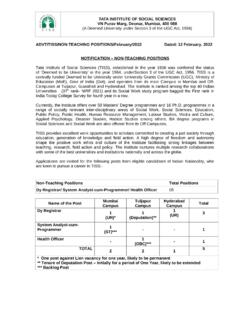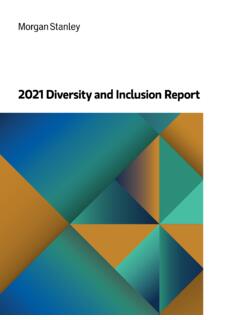Transcription of Concept of Primary Health Care - Gujarat Chapter
1 Module 1: Chapter 6 Concept of Primary Health Care Indian Association of Preventive and Social Medicine Gujarat Chapter PGCHSM-2013 Primary Health Care Concept Page 1 Concept OF Health FOR ALL AND Primary Health CARE In 1977, the Director General of WHO called for a new strategy, acknowledging that although the Health care strategies of the industrialized world-that of big hospitals, drugs and curative medicine-had been exported to developing countries for thirty years, the Health of the world had not improved. The International Conference on Primary Health Care was convened in Alma-Ata, Kazakhstan, in 1978 and was attended by virtually all the member nations of the World Health Organization (WHO) and UNICEF. 134 governments ratified the WHO Declaration of Alma-Ata, asserting that: (a) Health for all could be achieved by 2000.
2 (b) Governments have a responsibility for the Health of their people that can be fulfilled only by the provision of adequate Health and social measures. (c) Primary Health care is the key to attaining a level of Health that will permit their citizens to lead a socially and economically productive life. The Alma-Ata Declaration of 1978 emerged as a major milestone of the twentieth century in the field of public Health and it identified Primary Health Care (PHC) as the key to the attainment of the goal of Health for All (HFA). Definition of Health for All (HFA) HFA is defined as the attainment by all peoples of the world by a particular date (kept at that time as the year 2000), of a level of Health that will permit them to lead a socially and economically productive life . It does not imply that by that date, everybody in the world will have the most state of the art Health care but that by that date, everybody in the world will attain a level of Health so as to enable him or her to lead a physically, mentally, socially and economically fulfilling life and contribute fully, depending on his / her capabilities, towards the socio-economic development of the community and nation.
3 The Global Strategy for Health for All by the Year 2000 (HFA2000) set the following guiding targets to be achieved by year 2000: 1. Life expectancy at birth above 60 years 2. Infant mortality rate below 50 per 1000 live births 3. Under-5 mortality rate below 70 per 1000 live births. Health for All in the 21st Century In May 1998, the World Health Organisation adopted a resolution in support of the new global Health for All policy. The new policy, Health for All in the 21st Century, succeeds the Health for All by the Year 2000 strategy launched in 1977. In the new policy, the worldwide call for social justice is elaborated in key values, goals, objectives and targets. The 10 global Health targets are the most concrete end points to be pursued. They can be divided into three subgroups, viz. Health outcome targets (total four targets), targets PGCHSM-2013 Primary Health Care Concept Page 2 on determinants of Health (two) and targets on Health policies and sustainable Health systems (four targets).
4 Global Health Targets Health Outcome 1. Health equity: Childhood stunting By 2005, Health equity indices will be used within and between countries as a basis for promoting and monitoring equity in Health . Initially, equity will be assessed on the basis of a measure of child growth. 2. Survival : Maternal mortality rates, child mortality rates, life expectancy By 2020, the targets agreed at world conferences for maternal mortality rates (<100/100,000 live births), under 5 years or child mortality rates (<45/1000 live births) and life expectancy (>70 years) will be met. 3. Reverse global trends of five major pandemics: By 2020, the worldwide burden of disease will be reduced substantially. This will be achieved by implementing sound disease control programmes aimed at reversing the current trends of increasing incidence and disability caused by tuberculosis, HIV/AIDS, malaria, diseases related to tobacco and violence or trauma.
5 4. Eradicate and eliminate certain diseases: Measles will be eradicated by 2020. Lymphatic filariasis will be eliminated by the year 2020. The transmission of Chagas disease will be interrupted by 2010. Leprosy will be eliminated by 2010 and trachoma will be eliminated by 2020. In addition, vitamin A and iodine deficiencies will be eliminated before 2020. Determinants of Health 5. Improve access to water, sanitation, food and shelter: By 2020, all countries, through intersectoral action, will have made major progress in making available safe drinking water, adequate sanitation and food and shelter in sufficient quantity and quality and in managing risks to Health from major environmental determinants, including chemical, biological and physical agents. 6. Measures to promote help: By 2020, all countries will have introduced and be actively managing and monitoring, strategies those strengthen Health enhancing lifestyles and weaken Health damaging ones through a combination of regulatory, economic, educational, organisational and community based programmes.
6 PGCHSM-2013 Primary Health Care Concept Page 3 Health Policies and Sustainable Health Systems 7. Develop, implement and monitor national Health for All policies: By 2005, all member states will have operational mechanisms for developing, implementing and monitoring policies that are consistent with this Health for All policy. 8. Improve access to comprehensive essential Health care: By 2010, all people will have access throughout their lives to comprehensive, essential, quality Health care, supported by essential public Health functions. 9. Implement global and national Health information and surveillance systems: By 2010, appropriate global and national Health information, surveillance and alert systems will be established. 10. Support research for Health : By 2010, research policies and institutional mechanisms will be operational at global, regional and country levels.
7 The Member States of WHO have to translate the Regional Health Policy into realistic national policies backed up by appropriate implementation plans. WHO, on its part, will provide support to the Member States based on countries realities and needs, especially community Health problems, the strengthening of Health systems and services and the mobilization of countries and the international community for concerted action in the harmonization of national policies with regional and global policies. Primary Health Care Primary Health care is defined as essential Health care based on practical, scientifically sound and socially acceptable methods and technology, made universally accessible to individuals and families in the community through their full participation and at a cost that the community and country can afford to maintain at every stage of their development in the spirit of self-reliance and self-determination.
8 It forms an integral part both of the country s Health system, of which it is the central function and main focus and of the overall social and economic development of the community. It is the first level of contact of individuals, the family and community with the national Health system bringing Health care as close as possible to where people live and work and constitutes the first elements of a continuing Health care process. Primary Health Care was identified as the key measure through which HFA was envisaged to be achieved. In India the first National Health Policy in 1983 aimed to achieve the goal of Health for All by 2000 AD, through the provision of comprehensive Primary healthcare services. It PGCHSM-2013 Primary Health Care Concept Page 4 stressed the creation of an infrastructure for Primary healthcare; close co-ordination with Health related services and activities (like nutrition, drinking water supply and sanitation); active involvement and participation of voluntary organisations; provision of essential drugs and vaccines; qualitative improvement in Health and family planning services; provision of adequate training; and medical research aimed at the common Health problems of the people.
9 The Graded (3-Tier) System of Health Care In the curative domain there are various forms of medical practice. They may be thought of generally as forming a pyramidal structure, with three tiers representing increasing degrees of specialization and technical sophistication but catering to diminishing numbers of patients as they are filtered out of the system at a lower level. Only those patients who require special attention either for diagnosis or treatment should reach the second (advisory) or third (specialized treatment) tiers where the cost per item of service becomes increasingly higher. The first level represents Primary Health care, or first contact care, at which patients have their initial contact with the Health -care system. Primary Health care: It is an integral part of a country s Health maintenance system, of which it forms the largest and most important part.
10 It deals with the entire gamut of the community at the grass-root level. Primary Health care is a comprehensive team-work between medically qualified physician as well as a wide range of nursing and paramedical personnel. Quite often, Primary Health care systems are further subdivided into three levels - the most peripheral level which is in direct contact with the community and is usually managed by one or more members from within the community who are trained and equipped in preventive and Promotive Health care as well as in the most basic clinical and emergency care. The next higher level is managed by one or more nursing / paramedical workers, while the highest level within Primary Health acre is managed by a medical person along with his team of nursing and paramedical persons. In our country, these 3 levels correspond to the ASHA / VHG, MPWs at subentries and the Primary Health centre, respectively.






